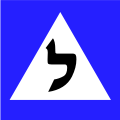L-plate

An L-plate is a square plate bearing a sans-serif letter L, for learner, which must be affixed to the front and back of a vehicle in many countries if its driver is a learner under instruction, or a motorcycle rider with provisional entitlement to ride restricted motorcycles.
Newly licensed drivers
Australia
In Australia the rules vary from state to state. A new driver holds a Learner licence/permit which has a minimum age of 16 or 15 and 9 months in some areas. This must then be held for a certain amount of time before a driving examination can be undertaken usually 12 months later.[1] After passing the driver must display 'P' plates. Holders of a provisional/probationary licence may be restricted compared to fully licensed drivers in speed, blood alcohol limits, limits on the type and power of their car's engine (i.e., no more than 6 cylinders, no forced induction), and number of demerit points that can be deducted.[2] VicRoads, the Victorian road authority, publish information for learner drivers on the L-Site.[3]
Graduated Driver Licensing (GDL) first commenced in Australia in the mid-1960s with New South Wales introducing learner and provisional licences in 1966. In all states, newly licensed drivers are required by law to display P-plates for varying lengths of time. The P is usually a red or green letter on a white background or a white letter on a red or green background (Victoria and Western Australia only). In New South Wales and Victoria there are two classes of provisional licence, red P-plates are for the first year after passing the Learner test and then after passing a computerised test they are green for two to three years. Western Australia requires six months of red P-plates, where provisional drivers are under a 12 am–5 am curfew, and one and a half years of green P-plates.
On 1 July 2000, New South Wales introduced a three-stage Graduated Licensing Scheme (GLS):
- Stage one is a learner licence with the requirement to complete 120 hours of supervised driving
- Stage two is a one-year P1 probationary licence (with red P plates).
- Stage three is a three-year P2 probationary licence (with green P plates).
On 1 July 2010, Victoria introduced the Graduated Licensing Systems (GLS).[4]
- Stage one is a one-year P1 probationary licence (with red P plates).
- Stage two is a three-year P2 probationary licence (with green P plates).
- P1 drivers are prohibited from using a mobile phone of any kind.
- P1 drivers are banned from towing, except for work or when supervised.
- P1 drivers can carry no more than one passenger aged between 16 years of age and less than 22 years, unless the passengers are immediate family members.
- A good driving record will be necessary to progress to the next licence stage.
As of July 2007, newly issued Queensland drivers licences have new restrictions for those under 25. Learners must first log 100 hours of driving experience (of which 10 must be undertaken at night) before taking their practical driving examination. Learners can boost this experience by taking professional lessons which counts for 3 times the hours, for up to 10 hours (or 30 logbook hours.) After a period of one year provisional drivers must then pass a hazard-perception test to move from red to green P-Plates where previously only a 3-year duration was required. New restrictions also prevent any under-25, Queensland provisional licence-holder from carrying more than one passenger under the age of 21, who is not an immediate family member, between the hours of 11 pm and 5 am.[5]
Speed limits
L-platers and the Red and Green P-platers are restricted in some states to a maximum speed of 90 km/h (56 mph) (in NSW) or 110 km/h (68 mph) (elsewhere), depending on the presence of an instructor. 100 km/h (62 mph) is allowed in certain states and territories, and these values are shown on the respective plates. Queensland, Victoria, and the ACT make no speed restrictions beyond the speed limits applicable to all drivers.
NSW learners must complete at least 120 hours of driving experience. Learners younger than 25 years must record their hours in a logbook and hold the licence for at least one year before taking the driving test; similar requirements were formerly imposed on drivers 25 and older, but it was removed in 2009. All other licensing requirements are identical.
Canada
Motor vehicles are provincially regulated in Canada, and so regulations vary by province. In British Columbia, following the instructional phase and after passing a road test, new drivers are required to show a green N (for novice) plate until they have passed an additional road test, usually after 24 months.
In British Columbia, a red L (for learner) plate is required for 12 months before the N can be issued, and new drivers with this marking are not permitted to drive without a licensed driver over the age of 25 present in the vehicle.[6]
France
After learners pass their driving test, they must display a A-plate (for apprenti), of round shape with white background and red letter, for 3 years (shortened to 2 years for those who took part in the conduite accompagnée program - a program allowing learner to drive with a licensed driver in the passenger seat and starting two years before the minimum driving age).
United Kingdom
All new drivers in the United Kingdom, upon receipt of a provisional licence, must display L plates at all times and be accompanied by another driver who is over 21 years of age and has held a full and valid licence for the type of vehicle being driven for at least three years. In Wales either red L plates or red D plates are permitted, due to the bilingual legislation in force within the country, while a learner is driving the vehicle.[7]
After learners have passed a driving test for the appropriate vehicle, they may opt to display green P-plates (P for probationary) to show that they have less experience than other drivers.[8] These plates are voluntary and not required by law or the Highway Code.[9]
L plates are required to be displayed at all times whilst riding a motorcycle or moped of no more than 125 cc (7.6 cu in) after passing motorcycle compulsory basic training (CBT) but before passing a full motorcycle test.
In Northern Ireland, for one year after the passing of a car or motorcycle driving test, the driver is defined as a "restricted driver" who must not exceed 45 mph (72 km/h) and must display an "R-plate" consisting of an amber sans-serif R on a white background.[10] L-plates in Northern Ireland commonly have an R-plate as a reverse side. "R-plate" drivers are often viewed as a nuisance on motorways, due to their limited speed, resulting in many restricted drivers not displaying their "R-plates" or not keeping to the restricted speed limit.[11][12]
Hong Kong
In Hong Kong, a person is allowed to apply for a learners' licence for private car, light good vehicle, motorcycle and motor tricycle once he or she has reached 18 years old. For learners' licence for other classes of vehicle, applicants must be over 21 years old and hold a valid full driving licence for three years or a probational driving licence for one year followed by a two years period with a full driving licence. Holders of such licence must be accompanied by a licensed driving instructor (except for person driving motorcycles and motor tricycle) and display L-plates at front and rear of the vehicle while driving. The L-plate is printed red on white with an alphabet "L" and a Chinese character "學".
A one-year probationary period has been applied to newly qualified motorcycle drivers since 2000 and to private car/light goods vehicle drivers since 2009. During the probationary period, drivers must display a P-plate at the front and back of the car, must not exceed a speed of 70 km/h (43 mph) if the speed limit of the road is higher than 70 km/h (43 mph), and may use the rightmost lane on expressways having three of more lanes. Motorcycle riders may not carry passengers during probation period. A driver who commits a minor traffic offence during the probationary period will see his period extended by six months, and a second minor offence or a single serious offence will cancel the license entirely, forcing him to retake the driving test for another probationary licence. Drivers who complete the probationary period without incident are eligible for a full-class driving licence. Licences for all other classes of vehicles require the applicant to have held a full private car/light goods vehicle driving licence for at least two years.
India
All new drivers in India, upon receipt of a provisional licence, must display L plates at all times (usually on the front and rear of the vehicle) and be accompanied by another driver who has held a full and valid licence for the type of vehicle being driven and also be in a position to control the vehicle.
After learners have passed the driving test for the appropriate vehicle, they can switch to a permanent driving license.
Isle of Man
Licences may be obtained from the age of 16 and provisional licences require the display of L-plates (similarly to Ireland and the UK). For one year after obtaining a full licence, R-plates (for restricted) must be displayed and speed is restricted to 50 mph (80 km/h) (even on unrestricted Manx roads). As in Northern Ireland, an R-plate is a red R on a square white plate.
Ireland
In Ireland, the minimum age for a learner's permit is seventeen. Before being awarded this permit, the applicant must pass a computerized Driver Theory Test, and after passing the test, the probationer must display L-plates (one front, and one rear) and be accompanied by a driver who has held a full licence for at least two years. Since 2008, all learner drivers have faced a fine of up to €1,000 for a first offence and €2,000 for a second if they fail to display L-plates.
All learner permit holders, with the exception of those who hold learner permits in category W (work vehicles/land tractors), must display 'L' plates while they are driving. The letter L should be at least 15 cm (5.9 in) high and appear as red on a white background, in clearly visible vertical positions to the front and rear of the vehicle.[13]
A learner's permit is valid for two years, and may be renewed once without the holder having sat a driving test. After this, proof of an upcoming test appointment or a recent test failure is required for further renewal. A permit holder may not sit a test for at least six months after receiving their permit.
Prior to October 2007, a "provisional licence" was issued which had more lax restrictions - on its first renewal, the holder could drive unaccompanied (but must continue to display L plates), and the accompanying driver did not need any experience, just a full licence. The third or further renewals of the licence - e.g. after failing a test and the expiration of the second licence - brought back the accompaniment requirement. This unusual arrangement led to a situation where a learner driver, having failed his driving test on a 2nd Provisional, could legally drive away from the test center unaccompanied.
Prior to December 2007 an L-plate was not required for motorcyclists. A fluorescent tabard displaying an 'L' on the rear is now required for motorcyclists using a provisional licence or learner permit.[14]
The new measures were introduced in an effort to improve road safety, and will be followed by the introduction of 'tiered licensing', with harsher rules applying to those holding a full licence for less than two years. However, the changes were not retroactive.
Israel
During the studies
In Israel, the driving tutoring has to be performed by a special teacher, named "Driving teacher" (Hebrew: מורה נהיגה). The lessons are performed on a modified vehicle with additional controlling pedals at the front passenger seat, — this allows the teacher to control the vehicle during lessons and prevent accidents. Additionally, auxiliary mirrors are fixed atop of side rear-view mirrors, providing the teacher with the rear views.
It is the teacher's responsibility to affix the L-plate before each lesson and to remove it after the lesson, therefore the L-plates are usually printed on PVC panels with magnetic base, which eases affixing and removal.
Israeli L-plate shares the general design of Israeli information signs (square form, blue background). On the blue background is placed a white triangle pointing upwards, with black Hebrew letter "ל" in it, from Hebrew: למידה — "Learning".
After passing the exam
For two years after passing the exam, the driver is required to affix a P-plate bearing the words "New driver" in Hebrew (נהג חדש; optionally, נהגת חדשה for female driver, or נהג\ת חדש\ה that suits both male and female drivers). The law defines the plate should be light-reflective with yellow background and black letters, it has to be fixed in a corner of the rear window, and there are lower limits on plate's size and width of the letters. The law restricts the usage of P-plates to new drivers only; the P-plate has to be fixed if and only if the person that drives the vehicle is a new driver.[15]
There are several restrictions on the new driver. For the first three months after receiving the license, he may drive only if there is an experienced driver sitting in the front passenger's seat, — and the law additionally defines the requirements for the driver to be called "experienced".[15] The charges for violating traffic laws are much more heavy on the new driver; there is a list of traffic law violations that immediately cancel the new driver's license.[16] Additional limitations apply on young drivers; i.e., if the new driver is younger than 21 years old, he may not transport more than two passengers without an experienced driver accompanying him in the front passenger's seat.
Japan
In Japan, new drivers must display a Shoshinsha mark (初心者マーク) (or Wakaba mark (若葉マーク)) on the front and rear of their vehicle for their first year. Although not related to driving experience, the Koreisha mark (高齢者マーク) is optional for drivers 70 years old or over and mandatory for 75 years or more. It would theoretically be possible to simultaneously display both a shoshinsha mark and a koreisha mark, for example if a 70-year-old were to be newly licensed.
Malaysia
In Malaysia, only cars approved by driving schools may be driven by Learner Drivers after passing the theory test. The car (typically a Perodua Kancil or Perodua Viva) is required to have at least one L-plate at the front and the back. In the case of motorcycles, Learner riders must affix an L-sticker onto the front and rear of their motorcycles. The learner's driving licence is renewable every 3 or 6 months but cannot be possessed for more than 2 years.[17]
The L-plate is very similar to those used in the United Kingdom and Singapore, with the exception being that two background colors are issued which are blue color background (for all vehicles except motorcycles) and white color background (for motorcycles only). They are allowed to take their practical driving test after 1 month of obtaining the Learner's license.
After the learner drivers pass their practical driving tests, they are put under the 2-year probationary period before they may possess the Competent Driving Licence. During the probationary period, they are issued with Probationary Driving Licence and are required to place P-plates at the front and the back of their respective vehicles. They are subject to the Kejara demerit system, where those accumulating 10 points or more during the 2-year probationary period may risk their licences to be revoked. The P-plate design is similar to its L-counterpart, except that the background colour is red and the letter P is white. After the probationary period ends, the drivers are given a one-year grace period to upgrade their licences to Competent Driving Licence.[18]
United States
New Jersey
In New Jersey, effective May 1, 2010, drivers under the age of 21 holding a learner's permit or probationary license must display 1-by-1⁄2-inch (2.5 cm × 1.3 cm) detachable red decals on the front and back license plates of their vehicles.
Similar plates


Elsewhere in the world, varying designs are used. In Germany, a usually red plate displaying the word Fahrschule (driving school) is placed on the vehicles during instruction. In Sweden, the plate is green or red (for driving schools) with the text Övningskör (driving practice).[19] In Czechoslovakia, a white L on a blue field, similar to the Swiss one, had been used, but many driving schools have stopped using them recently, instead tagging their cars with the word "Autoškola" ("car school"). In Italy, driving schools' cars are tagged with the words "Scuola guida" (driving school), and private cars with beginner drivers are tagged with a "P" capital letter: both signs are black on white reflective background. In Finland, a white triangle (equilateral with 16–25 cm sides) is used by driving schools' cars. Between 1972–1996, new drivers were limited to only drive up to 80 km/h (50 mph) in the first year, and had to use a yellow round "80" plaque (colloquially kahdeksankympin lätkä) in rear window or as a sticker on back of the cars.[20] Today, plaques like this are used only by cars that are technically restricted to 80 km/h.
Plate designs
-

A British, Irish, Indian, Malaysian or Singaporean L-plate
-

An alternative Welsh D-plate
-

L-plate used in Malaysia for other vehicles than motorcycles
-

An Australian or New Zealand L-plate
-

An Israeli L-plate
-

A Swiss and Belgian L-plate
-

L-plate in Hong Kong. The letter L and the traditional Chinese character 學 (meaning to learn) appears on the plate.
-

A Hungarian T-plate
-

P-plate (for probationary) in Hong Kong or Australia for newly qualified drivers.
-

A Macau L-plate
-

A British Columbian L-plate
-

A Manx R-plate.
-

A Northern Ireland R-plate.
-

An Ireland N-plate.
-

A Spanish new driver plate
-

A Spanish L-plate - for driving school
-
.svg.png)
Italian P-plate (for principiante, meaning beginner)
-
A Japanese L-plate
-

A Japanese shoshinsha mark (for new drivers)
-

A Japanese koreisha mark (for elderly drivers)
References
- ↑ http://www.vicroads.vic.gov.au/Home/Licensing/GettingYourLs/CarLearnerPermit.htm
- ↑ http://www.vicroads.vic.gov.au/Home/Licensing/GettingYourPs/CarProbationaryLicence.htm
- ↑ http://lsite.vicroads.vic.gov.au/Learners.html
- ↑ http://gls.arrivealive.vic.gov.au/sitewidecontent/key_changes/probationary_licences.html
- ↑ Licence - Young drivers in Queensland.
- ↑ About the graduated licensing program (GLP) in B.C.
- ↑ "Rules for drivers and motorcyclists (89 to 102)". The Highway Code. Retrieved 4 January 2013.
- ↑
- ↑ "Halfords Multifix P Plates". Halfords. Retrieved 4 January 2013.
- ↑ "Motor vehicle documentation learner and restricted driver requirements".
- ↑ BBC News Northern Ireland 31 July 2006 http://news.bbc.co.uk/1/hi/northern_ireland/5224390.stm
- ↑ Law on the R plate in Northern Ireland
- ↑ https://www.ndls.ie/about-the-learner-permit.html#other-requirements
- ↑ Licence - Road Safety Authority Rules of the Road
- 1 2 See Israeli Ministry of Transport web site (Hebrew).
- ↑ See Israeli Ministry of Transport web site (Hebrew).
- ↑ Lesen Belajar Memandu (LDL) saya telah tamat tempoh melebihi 2 tahun. Adakah saya masih boleh memperbaharuinya bagi membolehkan saya duduki ujian praktikal? (Malay) - FAQ from Malaysian Road Transport Department Website.
- ↑ Lesen Memandu - Berapa lamakah tempoh lesen memandu tamat jika saya tidak memperbaharuinya? (Malay) - FAQ from Malaysian Road Transport Department Website.
- ↑ Övningskörning - requirements in order to begin the driving practice
- ↑
http://www.vicroads.vic.gov.au/Home/Licences/GetYourPs/RestrictionsOnPs/Peerpassengerrestriction.htm
External links
UK Legislation
- Text of the The Motor Vehicles (Driving Licences) Regulations 1996, Schedule 4, as in force today (including any amendments) within the United Kingdom, from legislation.gov.uk
mandating the design of "L" and "D" plates (not the original legislation which introduced the mark)